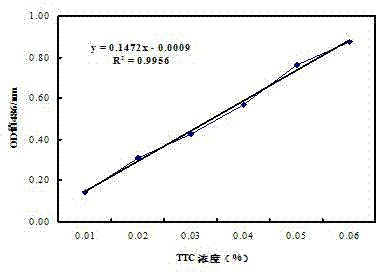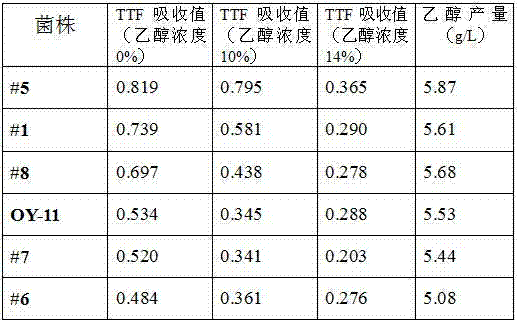Quantitative high-vitality yeast cell screening method based on TTC (2,3,5-triphenyltetrazolium chloride) staining method
A yeast cell and screening method technology, which is applied in the fields of bioengineering technology, medicine, and pharmacy, can solve the problems of unquantifiable, slow growth, time-consuming and labor-intensive, etc., and achieve the effect of saving detection costs, reducing human errors, and reducing screening time
- Summary
- Abstract
- Description
- Claims
- Application Information
AI Technical Summary
Problems solved by technology
Method used
Image
Examples
Embodiment 1
[0027] High Throughput Screening of Highly Viable Yeast
[0028] 1. Drawing of TTF standard curve
[0029] Take 0.005, 0.01, 0.02, 0.03, 0.04, 0.05, 0.06, 0.07, 0.08, 0.09, 0.1% (W (g) / V (mL)) TTC solution 1ml into a 10ml centrifuge tube, add 2ml of Tris- HCl (pH8.4), finally add 10% (W(g) / V(mL)) of Na 2 S 2 o 4 Solution 1ml, shake in 37℃ water bath for 5min (the above steps are all performed in the dark), so that TTC is completely reduced to TTF, centrifuge at 10000r / min for 10min, discard the supernatant, add 5ml of dimethyl sulfoxide with a concentration of 85% (v / v) The solution is fully mixed, and the absorbance value is measured at 486nm, and the absorbance value of the mixed solution at 486nm is used as the ordinate, and the TTC concentration is used as the abscissa to draw a standard curve. The standard curve obtained by drawing is shown in figure 1 : It can be seen from the standard curve that when the TTC concentration is 0.01-0.06%, the OD value is in the range...
PUM
 Login to View More
Login to View More Abstract
Description
Claims
Application Information
 Login to View More
Login to View More - R&D
- Intellectual Property
- Life Sciences
- Materials
- Tech Scout
- Unparalleled Data Quality
- Higher Quality Content
- 60% Fewer Hallucinations
Browse by: Latest US Patents, China's latest patents, Technical Efficacy Thesaurus, Application Domain, Technology Topic, Popular Technical Reports.
© 2025 PatSnap. All rights reserved.Legal|Privacy policy|Modern Slavery Act Transparency Statement|Sitemap|About US| Contact US: help@patsnap.com


